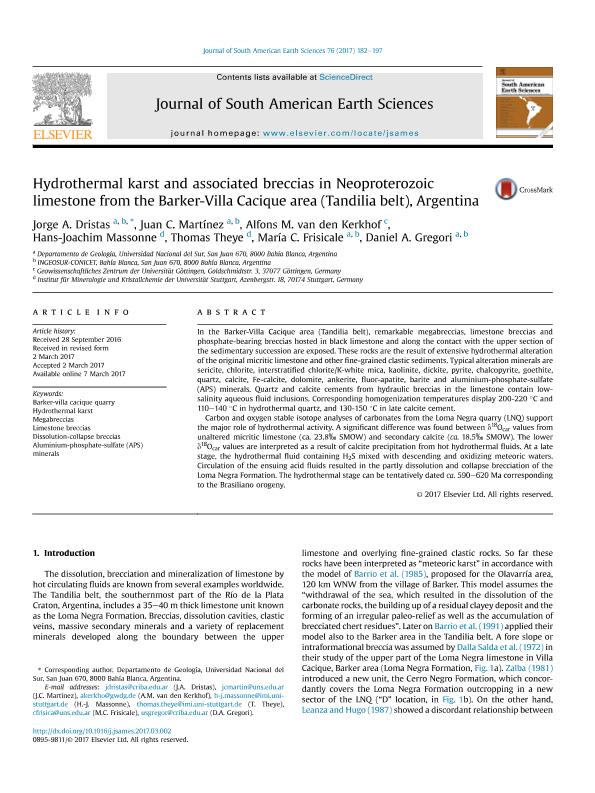Mostrar el registro sencillo del ítem
dc.contributor.author
Dristas, Jorge Anastasio

dc.contributor.author
Martinez, Juan Cruz

dc.contributor.author
van den Kerkhof, Alfons M.
dc.contributor.author
Massonne, Hans Joachim
dc.contributor.author
Theye, Thomas
dc.contributor.author
Frisicale, Maria Cristina

dc.contributor.author
Gregori, Daniel Alfredo

dc.date.available
2018-09-12T19:22:43Z
dc.date.issued
2017-07
dc.identifier.citation
Dristas, Jorge Anastasio; Martinez, Juan Cruz; van den Kerkhof, Alfons M.; Massonne, Hans Joachim; Theye, Thomas; et al.; Hydrothermal karst and associated breccias in Neoproterozoic limestone from the Barker-Villa Cacique area (Tandilia belt), Argentina; Pergamon-Elsevier Science Ltd; Journal of South American Earth Sciences; 76; 7-2017; 182-197
dc.identifier.issn
0895-9811
dc.identifier.uri
http://hdl.handle.net/11336/59408
dc.description.abstract
In the Barker-Villa Cacique area (Tandilia belt), remarkable megabreccias, limestone breccias and phosphate-bearing breccias hosted in black limestone and along the contact with the upper section of the sedimentary succession are exposed. These rocks are the result of extensive hydrothermal alteration of the original micritic limestone and other fine-grained clastic sediments. Typical alteration minerals are sericite, chlorite, interstratified chlorite/K-white mica, kaolinite, dickite, pyrite, chalcopyrite, goethite, quartz, calcite, Fe-calcite, dolomite, ankerite, fluor-apatite, barite and aluminium-phosphate-sulfate (APS) minerals. Quartz and calcite cements from hydraulic breccias in the limestone contain low-salinity aqueous fluid inclusions. Corresponding homogenization temperatures display 200-220 °C and 110–140 °C in hydrothermal quartz, and 130-150 °C in late calcite cement. Carbon and oxygen stable isotope analyses of carbonates from the Loma Negra quarry (LNQ) support the major role of hydrothermal activity. A significant difference was found between δ18Ocar values from unaltered micritic limestone (ca. 23.8‰ SMOW) and secondary calcite (ca. 18.5‰ SMOW). The lower δ18Ocar values are interpreted as a result of calcite precipitation from hot hydrothermal fluids. At a late stage, the hydrothermal fluid containing H2S mixed with descending and oxidizing meteoric waters. Circulation of the ensuing acid fluids resulted in the partly dissolution and collapse brecciation of the Loma Negra Formation. The hydrothermal stage can be tentatively dated ca. 590–620 Ma corresponding to the Brasiliano orogeny.
dc.format
application/pdf
dc.language.iso
eng
dc.publisher
Pergamon-Elsevier Science Ltd

dc.rights
info:eu-repo/semantics/openAccess
dc.rights.uri
https://creativecommons.org/licenses/by-nc-sa/2.5/ar/
dc.subject
Aluminium-Phosphate-Sulfate (Aps) Minerals
dc.subject
Barker-Villa Cacique Quarry
dc.subject
Dissolution-Collapse Breccias
dc.subject
Hydrothermal Karst
dc.subject
Limestone Breccias
dc.subject
Megabreccias
dc.subject.classification
Meteorología y Ciencias Atmosféricas

dc.subject.classification
Ciencias de la Tierra y relacionadas con el Medio Ambiente

dc.subject.classification
CIENCIAS NATURALES Y EXACTAS

dc.subject.classification
Mineralogía

dc.subject.classification
Ciencias de la Tierra y relacionadas con el Medio Ambiente

dc.subject.classification
CIENCIAS NATURALES Y EXACTAS

dc.title
Hydrothermal karst and associated breccias in Neoproterozoic limestone from the Barker-Villa Cacique area (Tandilia belt), Argentina
dc.type
info:eu-repo/semantics/article
dc.type
info:ar-repo/semantics/artículo
dc.type
info:eu-repo/semantics/publishedVersion
dc.date.updated
2018-09-10T15:55:59Z
dc.journal.volume
76
dc.journal.pagination
182-197
dc.journal.pais
Estados Unidos

dc.journal.ciudad
Amsterdam
dc.description.fil
Fil: Dristas, Jorge Anastasio. Consejo Nacional de Investigaciones Científicas y Técnicas. Centro Científico Tecnológico Conicet - Bahía Blanca. Instituto Geológico del Sur. Universidad Nacional del Sur. Departamento de Geología. Instituto Geológico del Sur; Argentina
dc.description.fil
Fil: Martinez, Juan Cruz. Consejo Nacional de Investigaciones Científicas y Técnicas. Centro Científico Tecnológico Conicet - Bahía Blanca. Instituto Geológico del Sur. Universidad Nacional del Sur. Departamento de Geología. Instituto Geológico del Sur; Argentina
dc.description.fil
Fil: van den Kerkhof, Alfons M.. Universität Göttingen; Alemania
dc.description.fil
Fil: Massonne, Hans Joachim. Universität Stuttgart; Alemania
dc.description.fil
Fil: Theye, Thomas. Institut für Mineralogie und Kristallchemie. Universität Stuttgart; Alemania
dc.description.fil
Fil: Frisicale, Maria Cristina. Consejo Nacional de Investigaciones Científicas y Técnicas. Centro Científico Tecnológico Conicet - Bahía Blanca. Instituto Geológico del Sur. Universidad Nacional del Sur. Departamento de Geología. Instituto Geológico del Sur; Argentina
dc.description.fil
Fil: Gregori, Daniel Alfredo. Consejo Nacional de Investigaciones Científicas y Técnicas. Centro Científico Tecnológico Conicet - Bahía Blanca. Instituto Geológico del Sur. Universidad Nacional del Sur. Departamento de Geología. Instituto Geológico del Sur; Argentina
dc.journal.title
Journal of South American Earth Sciences

dc.relation.alternativeid
info:eu-repo/semantics/altIdentifier/doi/http://dx.doi.org/10.1016/j.jsames.2017.03.002
dc.relation.alternativeid
info:eu-repo/semantics/altIdentifier/url/https://www.sciencedirect.com/science/article/pii/S0895981116302073
Archivos asociados
